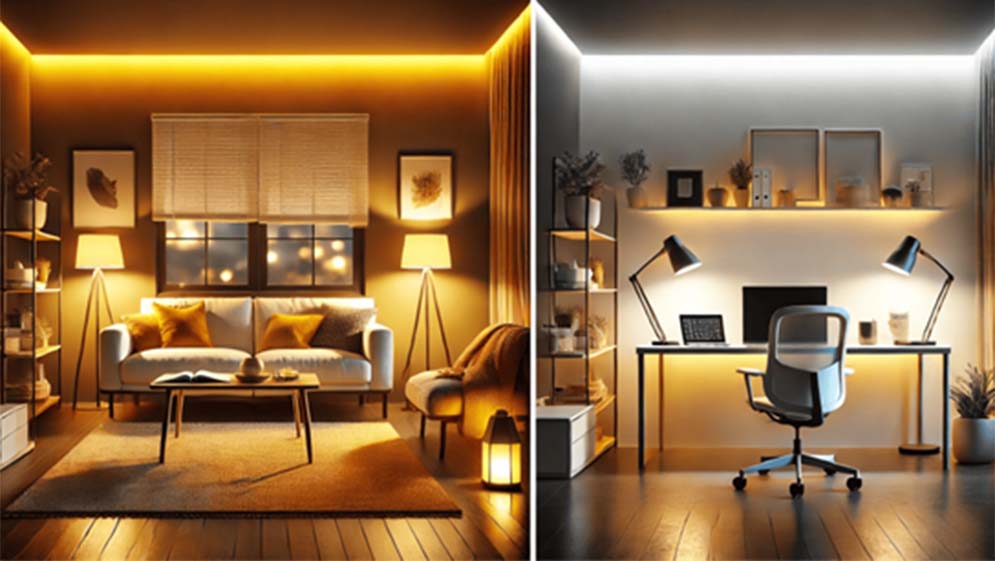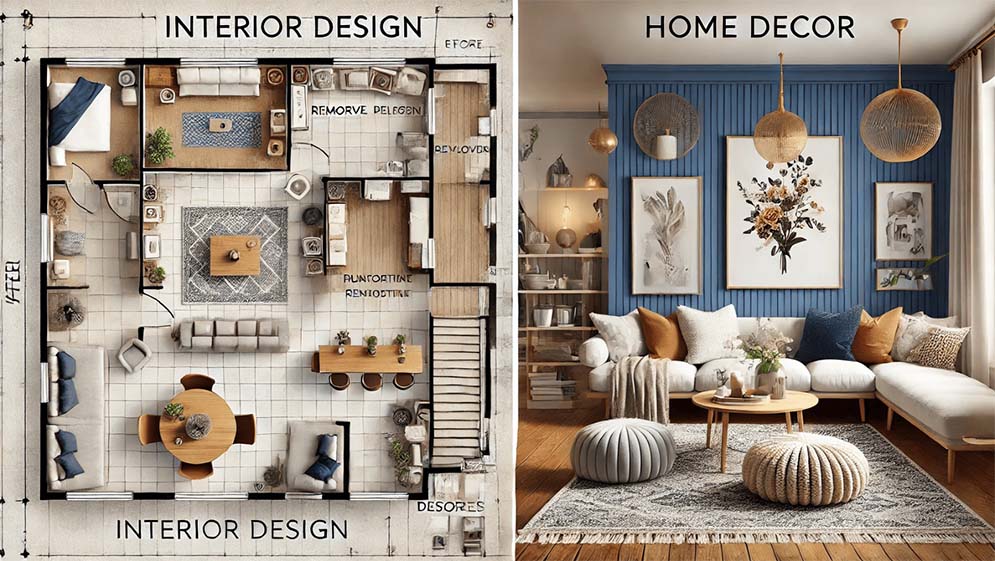In the past few years, LED lighting has emerged as the preferred choice for commercial and residential spaces. Durable and energy-efficient LED lights come with a variety of hues, making it easy for homeowners and designers to design the perfect atmosphere. The most sought-after options are white and yellow LED lighting. Although both have the same basic purpose of lighting, their color intensities, as well as the impact on the surrounding environment, are different. In this article, we'll look at the differences between the yellow and. White LED lights to help you select the best light source for your requirements.
What is Yellow LED Lighting?

Characteristics of Yellow LED Light
The yellow LED light typically lies between 2700 K and 3000 K on the scale of color temperatures. It creates a warm, subtle glow that is similar to incandescent lights. Its yellow hue resembles that of the sun's natural light in the evening and at sunset, creating a warm and relaxing ambience. The type of light is commonly described as "warm white" due to its cozy and inviting appearance.
Advantages of Yellow LED Lighting
Creates Cozy and Comfortable Atmosphere: Yellow lighting is known for its capacity to turn an area into a cozy, calming place. This is ideal for living areas, bedrooms, dining, and living spaces where relaxation is a top priority.
Lowers Eye Strain: In comparison with white light, yellow LED lighting is softer and gentler on the eyes. It is a great option for areas in which you want to unwind and relax.
Flexibility: Lights in the form of yellow LED can be found in various environments, from home to dining establishments, since they create a welcoming and cozy atmosphere.
Disadvantages of Yellow LED Lighting
Low brightness: The yellow LED lights are generally less bright than the white LED lights. This renders them unsuitable for jobs that require high luminosity, like working in a precise manner or reading in the dark.
Not suitable for spaces that are task oriented: It is not ideal for work spaces, kitchens or bathrooms in which light that is bright and focused is required for activities such as cooking, cleaning, or personal grooming.
Can create a dull Atmosphere: If you're in contemporary and larger rooms with yellow light, it could make rooms appear old or too warm. This could not work for spaces that require a lively or active ambience.
Low quality light for work: Soft warm glow of the yellow LED may not have the clarity and sharpness required to perform high-focus tasks, which can reduce its efficiency in working conditions.

Common Uses of Yellow LED Lighting
Rooms and Living Rooms as well as Bedrooms: The yellow LED lighting is great to create a comfortable and relaxing environment in areas intended for relaxation and stress-free.
Dining rooms: Commonly utilized in dining spaces for providing a warm, inviting atmosphere, which enhances dining enjoyment.
Accent lighting: Perfect for highlighting certain areas, like art or architectural elements, and giving warmth to the room.
Cafes and restaurants are often utilized in these spaces to create a serene and intimate environment that promotes peace and relaxation throughout meals.
Hotels and Lounges: The yellow LED light can be used frequently to provide an inviting and warm atmosphere to guest rooms and lounges. This improves the experience of guests.
What is White LED Lighting?

Characteristics of White LED Light
White LED illumination, on the other hand, is cooler in hue, usually ranging between 4000K and 6500 K. It gives bright, crisp light that is similar to daylight. White LED light is classified into two types: cool white (4000K to 5500K) as well as daylight white (5000K to 6500K). White's cooler shades of LED lighting are ideal for spaces with a need for high-quality, bright lighting.
Advantages of White LED Lighting
High clarity and brightness: White LED light is brighter than yellow LED light, which makes it perfect in environments in which clarity and accuracy are vital.
Enhances Productivity and Alertness: The stimulating effects of white LED lighting can be found in workspaces in kitchens, offices, and other areas in which concentration and focus are crucial.
Imitates Natural Daylight: The white LED of day closely mimics natural sunlight, which is beneficial in maintaining the healthy rhythm of your circadian cycle, particularly during the daytime.
Disadvantages of White LED Lighting
Could feel too harsh or cold: The white LED light, especially in high hues (above 5500K), may be harsh and sterile. If you are in a space designed for relaxation, like bedrooms and living spaces, the white LED lighting can cause an uncomfortable and unwelcoming environment.
Unsettling to Sleep: White LED light, particularly that imitates daylight conditions, may disrupt the rhythm of your circadian cycle and disturb sleep when employed in the evening or just before you go to bed. Being exposed to light that is bright and white could reduce melatonin production, hindering your ability to sleep.
Can cause strain on the eyes: The intensity and the brightness of LED in white, especially when they are used excessively or with no proper dimming, may cause irritation and strain to the eyes over extended periods of time, in particular workplaces that have harsh, intense light sources.

Common Uses of White LED Lighting
Kitchens and Workspaces: Lights with white LED give the necessary brightness to cook, clean, and perform other chores. This clarity is very beneficial for areas that require focus on detail.
Offices or Study Rooms: The white LED lighting aids in improving efficiency and concentration, which makes it ideal for office spaces or study spaces.
Bathrooms and Hallways: Lighting with white LED provides an unobstructed view, which is vital in bathrooms as well as hallways.
Yellow vs White LED Lighting: Key Differences

Color Temperature and Appearance
The main difference that is noticeable between white and yellow LED lighting is the color temperature. Light from yellow LED, due to warmer tones, provides the feeling of a cozy, relaxed atmosphere, and white LED lights provide more cool, brighter light similar to daylight. Lights that are yellow tend to create an intimate, nostalgic environment, while white light can be considered the most modern and energizing.
Brightness and Light Distribution
White LED lights are generally larger and brighter in comparison to yellow LED lights, which makes them ideal for task-oriented rooms. However, the yellow LED light bulbs provide an ethereal, soft illumination that evenly spreads over a space. This can be ideal for areas of relaxation. The light distribution with a yellow LED is lower in intensity, which creates an enjoyable environment for long exposure.
Effect on Mood and Atmosphere
A yellow colored LED light provides a warm and calming appearance that induces the feeling of relaxation and peace. The majority of homes use it in rooms where people can spend their time relaxing after a tiring day. White LED lighting, on the contrary, provides a stimulation and energizing effect. It is able to increase productivity and focus, and is ideal for office spaces, kitchens, as well as other places that need focus.
Choosing the Right LED Lighting for Different Spaces

Living Rooms and Bedrooms
In the bedrooms and living areas for bedrooms and living rooms, LED lights in yellow are usually the ideal selection. Its soft, warm glow provides a soothing atmosphere ideal for relaxing. You can consider using LED with yellow along with dimmers in order to alter the brightness depending on the needs.
Kitchens and Offices
In offices and kitchens, White LED lighting is usually the preferred choice. The bright and clear light lets you concentrate easily on your tasks, regardless of whether you're cooking or doing your homework.
Bathrooms and Hallways
White and yellow LED lighting are suitable in hallways and bathrooms, according to the effect you want. The white LED light is ideal to provide clear and bright lighting, whereas yellow Led lights create the most relaxing and warm ambience in these spaces.
Energy Efficiency
White and yellow LED lighting choices are efficient in energy use and are powered by LED technology, being renowned for their lower energy use as well as their long lasting life. White LEDs typically require more power to reach a similar brightness to yellow LEDs. However, their consumption of energy is still minimal compared to conventional lighting sources like halogens or incandescent, and LEDs are a sustainable alternative.
Health Considerations
The exposure to light could significantly influence your health, and in particular, the way you sleep. The yellow LED light, due to its warm hues, will not disrupt the circadian rhythm. This makes it the ideal option in bedrooms or relaxation areas. Lighting with white LED, particularly daylight white, may reduce the production of melatonin, which could interfere with your rest if you use it late into the late at night.
Cost Comparison
The white and yellow LED bulbs are inexpensive in comparison to conventional lighting options. Although the initial price for the bulbs could be higher than the others however their efficiency in energy will ensure the long-term benefits. White LEDs are generally higher priced in comparison to yellow LEDs because of their greater brightness, as well as the technologies required to create these bulbs. Both options can be operated at a lower cost as compared to halogen or incandescent bulbs.
How to Adjust Yellow and White LED Lighting in Your Home

A lot of modern LED systems permit you to control both lighting intensity as well as color temperature, and give you the flexibility of making the right lighting choices to suit any space. You can consider dimmable LED bulbs or lighting options that can change between white and yellow lighting based on the needs of your home.
Conclusion
In deciding between yellow and white LED lights, you need to take into consideration what you'll do with your space, what atmosphere you'd like to establish, as well as the impact of lighting on your health. The yellow LED light is perfect in rooms that require an inviting, warm, and calming atmosphere. This includes bedrooms or living spaces. However, the white light source is best in areas that require clean, bright lighting to perform tasks such as office spaces, kitchens, or bathrooms.
Both kinds of LED lighting are efficient and long-lasting, bringing an excellent return on investment for the office or home. In the end, your decision is based on the particular requirements of your space, aiding you in creating the ideal atmosphere for productivity or relaxation.
FAQs
1. Is a yellow LED light best for relaxing?
The yellow light can create a relaxing and peaceful ambience, and is ideal for relaxing.
2. Could white LED light be used to read?
White LED light is clear and bright and is ideal to read and do detailed work.
3. Which type of LED light source has the most energy-efficient lighting?
Both white and yellow LED lights consume less energy, however, white LED typically require more power in order to attain similar brightness to yellow LED.
4. Which is the most efficient LED lighting option for kitchens?
The white LED light is great for kitchens because of its focus and bright illumination, and is great for cooking and cleaning.
5. Are there any advantages to using the white and yellow LED lights in conjunction?
It is possible to combine the two types of lighting in various rooms of your house to create a harmonious, practical, functional, and visually pleasant space.
6. Do white LED lights influence the quality of sleep?
White LED lighting, particularly daylight white, may reduce melatonin production and impact sleep quality when it is used at midnight.



